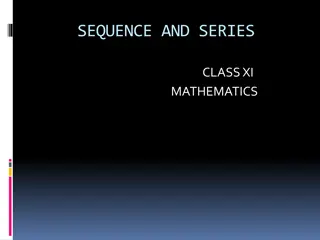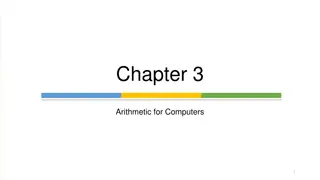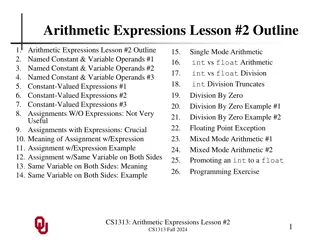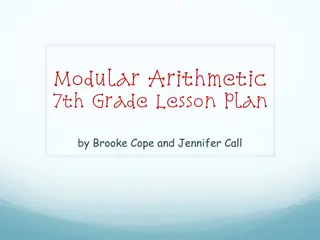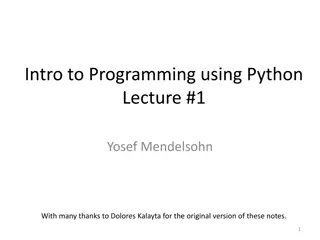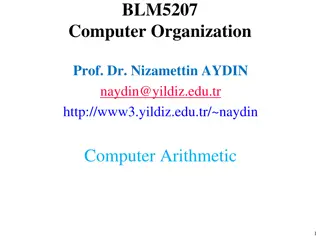Arithmetic Progression (AP) Concepts
Arithmetic Progression (AP) is a sequence where each term is derived by adding a fixed number to the previous term. This concept is explored through common difference, identifying terms in an AP, finding value of unknowns, sum of terms formula, and derivations. Examples and problems demonstrate the application of AP concepts in determining the number of terms.
Download Presentation

Please find below an Image/Link to download the presentation.
The content on the website is provided AS IS for your information and personal use only. It may not be sold, licensed, or shared on other websites without obtaining consent from the author.If you encounter any issues during the download, it is possible that the publisher has removed the file from their server.
You are allowed to download the files provided on this website for personal or commercial use, subject to the condition that they are used lawfully. All files are the property of their respective owners.
The content on the website is provided AS IS for your information and personal use only. It may not be sold, licensed, or shared on other websites without obtaining consent from the author.
E N D
Presentation Transcript
If various terms of a sequence are formed by adding a fixed number to the previous term or the difference between two successive terms is a fixed number, then the sequence is called AP. For example : 5, 10, 15, 20, 25 .. In this each term is obtained by adding 5 to the preceding term except first term
The general form of an Arithmetic Progression is a , a +d , a + 2d , a + 3d , a + (n-1)d Where, a is first term and d is called common difference.
Common Difference - The fixed number which is obtained by subtracting any term of AP from its succeeding term. If we take first term of an AP as a and Common Difference as d, Then, nth term of that AP will be an = a + (n-1)d
To check that a given term is in A.P. or not. 2, 6, 10, 14 . Here first term a = 2, Now, find differences in the next terms a2-a1 = 6 2 = 4 a3-a2 = 10 6 = 4 a4-a3 = 14 10 = 4 Since the differences are common. Hence the given terms are in A.P.
Problem : Find the value of k for which the given series is in A.P. 4, k 1 , 12 Solution : Given A.P. is 4, k 1 , 12 .. If series is A.P. then the differences will be common. a2 a1 =a3 a2 k 1 4 = 12 (k 1) k 5 = 12 k + 1 k + k = 12 + 1 + 5 2 k = 18 or k = 9
SUM OF n TERMS OF AN ARITHMETIC PROGRESSION Its formula is Sn = n [ 2a + (n - 1)d ] It can also be written as Sn = n [ a + an ]
DERIVATION The sum to n terms is given by: Sn= a + (a + d) + (a + 2d) + + [a + (n 1)d] (1) If we write this out backwards, we get: Sn = [a + (n 1)d] + (a + (n 2)d) + +a (2) Now let s add (1) and (2): 2Sn = [2a + (n 1)d] + [2a + (n 1)d] + + [2a + (n 1)d] So, Sn = n [2a + (n 1)d]
Problem . Find number of terms of A.P. 100, 105, 110, 115,, 500 Solution. First term is a = 100 , an = 500 Common difference is d = 105 -100 = 5 nth term is an = a + (n-1)d 500 = 100 + (n-1)5 500 - 100 = 5(n 1) 400 = 5(n 1) 5(n 1) = 400
5(n 1) = 400 n 1 = 400/5 n - 1 = 80 n = 80 + 1 n = 81 Hence the no. of terms in the AP are 81.
Problem Find the sum of 30 terms of given A.P. ,12 , 20 , 28 , 36 Solution : Given A.P. is 12 , 20, 28 , 36 Its first term is a = 12 Common difference is d = 20 12 = 8 The sum to n terms of an AP Sn = n [ 2a + (n - 1)d ] = x 30 [ 2 x 12 + (30-1)x 8]
= 15 [ 24 + 29 x 8] = 15[24 + 232] = 15 x 246 = 3690 THE SUM OF TERMS IS 3690
Problem . Find the sum of terms in given A.P. 2 , 4 , 6 , 8 , 200 Solution: Its first term is a = 2 Common difference is d = 4 2 = 2 nth term is an = a + (n-1)d 200 = 2 + (n-1)2 200 - 2 = 2(n 1) 2(n 1) = 198 n 1 = 99, n = 100
Now, the sum to n terms of an arithmetic progression Sn = n [ 2a + (n - 1)d ] S100 = x 100 [ 2x 2 + (100-1)x 2] = 50 [ 4 + 198] = 50[202] = 10100








